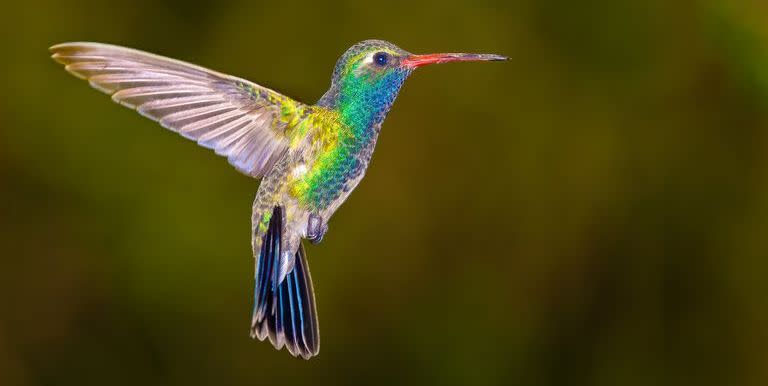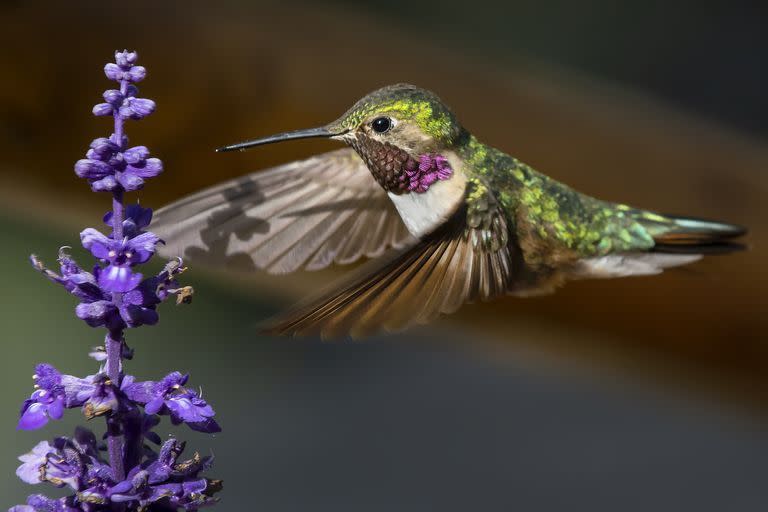Hummingbirds Can See Colors That the Human Eye Can't

Researchers have spent three years studying hummingbirds to deduce whether they can distinguish between spectral and nonspectral colors.
A newly published paper has confirmed that these incredible tiny creatures indeed have the ability to tell the difference between these color types and that they can see colors completely unknown to the human eye.
Hummingbirds are one of nature’s incredible wonders—they run on a diet fueled mostly by high levels of sugar (and sometimes insects), they’re almost constantly on the move, and now we’ve found out that they can see colors on the spectrum that humans can’t even imagine.
A recent paper published in the Proceedings of the National Academy of Sciences of the United States of America (PNAS) describes the ability of some animals—hummingbirds in particular—to see nonspectral colors. This refers to colors that don’t appear in the spectrum of visible light (you can think of spectral colors as being the ones we can see in a rainbow.)
Purple is the only nonspectral color that humans can see. Even though you might argue that purple is indeed visible in a rainbow, it’s actually violet that we see every time one appears overhead in the distance.
Hummingbirds have the ability to see nonspectral colors thanks to four color cone types present in their eyes (a phenomenon known as tetrachromacy); humans only have three cone types (trichromacy) and although it doesn’t seem like such a big disparity, when it comes to seeing color, that fourth cone type makes all the difference.
To find out how hummingbirds perceive color, the research group set up workstations at the Rocky Mountain Biological Laboratory (RMBL) in Colorado where they trained wild broad-tailed hummingbirds (Selasphorus platycercus) to actively participate in their experiment. The group was careful to keep their work environment as natural as possible for the birds over the course of the three years they worked on this study.

“Most detailed perceptual experiments on birds are performed in the lab, but we risk missing the bigger picture of how birds really use color vision in their daily lives,” says Mary Caswell Stoddard, assistant professor at Princeton University’s Department of Ecology and Evolutionary Biology, who led the research efforts.
“Hummingbirds are perfect for studying color vision in the wild. These sugar fiends have evolved to respond to flower colors that advertise a nectar reward, so they can learn color associations rapidly and with little training,” says Stoddard.
In order to test how well S. platycercus could see nonspectral colors, Stoddard and team “built a pair of custom ‘bird vision’ LED tubes programmed to display a broad range of colors, including nonspectral colors like ultraviolet+green” according to a Princeton University news release. Then, the team would wake up before sunrise to set up two feeders; one held a sugar water mixture while the second contained plain water.
Each feeder has a LED tube next to it with the sugar water feeder giving off a certain color while the plain water feeder gave off a different color. In order to see if the birds were truly differentiating between the feeders due to color, they would switch the positions of the feeders around “so the birds could not simply use location to pinpoint a sweet treat.”
“[Researchers] also performed control experiments to ensure that the tiny birds were not using smell or another inadvertent cue to find the reward. Over the course of several hours, wild hummingbirds learned to visit the rewarding color. Using this setup, the researchers recorded over 6,000 feeder visits in a series of 19 experiments.”
The results showed that the birds were actively able to differentiate between the sweet water feeder and the plain one because of the consistent color coding researchers used.
“The ultraviolet+green light and green light looked identical to us, but the hummingbirds kept correctly choosing the ultraviolet+green light associated with sugar water. Our experiments enabled us to get a sneak peek into what the world looks like to a hummingbird,” said paper co-author Harold Eyster.
The researchers concluded that the hummingbirds “can discriminate a variety of nonspectral colors, including UV+red, UV+green, purple, and UV+yellow”—colors that the human eye cannot see.
The team also theorizes that these little guys “perceive many natural colors as nonspectral” after analyzing approximately 3,300 plumage and plant colors; what looks like a vibrant flower to us could be a completely different color to a hummingbird. This could indicate that the ability to perceive nonspectral colors may be a critical for “signaling and foraging.”
Still, we can’t be sure what these birds are seeing, for now, we just know that they can see an array of colors the remains invisible to the human eye.
You Might Also Like

